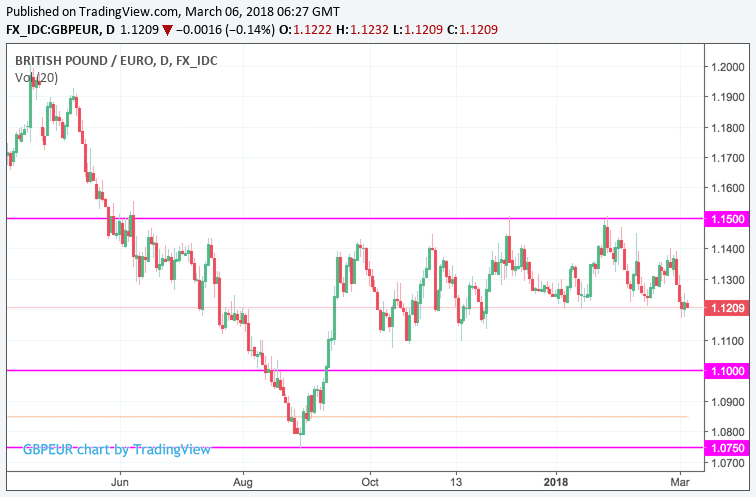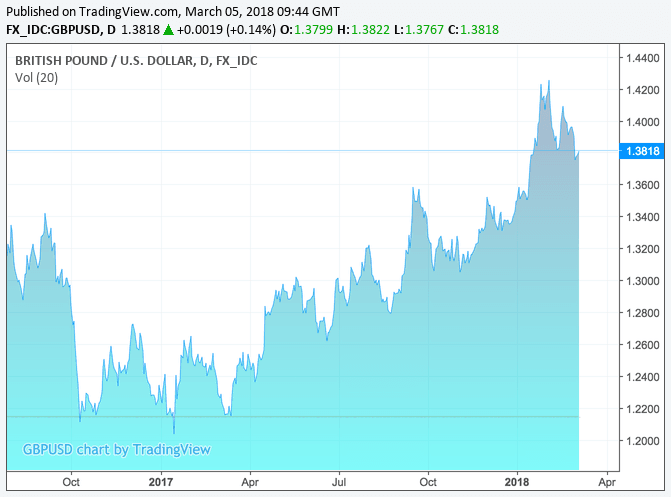Pound Outlook: The Strategists Betting on a Short-Term Recovery vs. Euro and Dollar
Currency strategists give their view on the near-term prospects facing the British Pound, and on balance some relief should be expected.
The Pound is seen trading with a stronger tone this week with the Pound-to-Euro exchange rate solidifying ground above 1.12 and potentially eyeing a move back to the long-term pivot point at 1.13, a level it appears to be most comfortable with.
The Pound-to-Dollar exchange rate has meanwhile faded back below 1.40 over recent weeks as the broader Dollar undergoes a recovery within its longer-term downtrend.
"GBP/USD’s break lower last week through several key supports lacked follow through and we are allowing for a near term rebound. Resistance is provided by the 20 day ma at 1.3911 and the resistance line at 1.4032. While capped here, the outlook stays negative," says Karen Jones, a technical analyst with Commerzbank.
However, Brent Donnelly who sits on the Trading Desk at HSBC Bank USA in New York reckons markets might be getting it wrong on the Pound, and a near-term recovery could be in order.
"The market now seems to be peak bearish UK just as Rees-Mogg sounds conciliatory and 'Mayxit' risks have dissipated. The 48 letters pressure has subsided and the front pages of the UK papers this weekend were about Trump and the snowstorm, not Brexit. A few weeks ago it was all Brexit all the time," says Donnelly.
Concerning the Pound specifically, Donnelly thinks "the market has built a substantial short GBPUSD and GBPJPY position just as the fundamentals looks just a bit less bad. So as much as I am skeptical on the Bank of England hiking more than once, in the short run I would not be at all surprised if GBPUSD revisits 1.4000."
Hamish Pepper, a foreign exchange strategist at Barclays in London meanwhile tells clients that there is "room for a near-term sterling bounce".
With little data to dictate direction, Pepper says Stelring's path should be dominated by digestion of Brexit news.
"UK Prime Minister May struck a conciliatory but firm tone in her speech last Friday. She remained firm that UK will remain outside the Customs Union, but proposed two solutions to facilitate ease of trade between the two key trading partners, she highlighted areas where the UK could accept EU regulation and even ECJ jurisdiction, while clearly carving out UK parliamentary sovereignty," says Pepper.
Further, "she mapped out areas where enhanced trade agreements could be achieved, even as she acknowledged the UK financial services would lose passporting rights."
Barclays see her speech as a measured response to the EU draft agreement, which was implicitly rejected, and the start of more serious negotiations.
"With GBP having already priced in more adverse outcomes on the back of EU chief negotiator Michel Barnier’s draft agreement, we see room for GBP to appreciate as the market absorbs the underlying conciliation in PM May’s speech. EU officials’ responses over the week likely will provide two-way volatility, however," says Pepper.
But not everyone is convinced Sterling is tilted to the upside in the near-term. Shaun Osborne at Scotiabank is looking for Sterling to resume its recent trend of weakening:
"The pound traded heavily overall last week but has managed to stabilize through late last week; we think the consolidation in Cable may just represent a pause before the pound takes another dive as price seems to be forming a bear flag signal (renewed downside momentum below 1.3780 currently). Resistance is 1.3850. Look to fade GBP rallies."
And, readers would do well to consider the views of analyst Lucy Lillicrap at AFEX who warns the Pound could be gearing up to test its recent multi-month lows towards 1.07 against the Euro.
"Indeed at some point this macro bearish cycle is likely to force prices to new historic lows again," warns Lillicrap. "Values have also only recently failed to establish themselves back above the psychological 1.1500 level."
Advertisement
Get up to 5% more foreign exchange by using a specialist provider to get closer to the real market rate and avoid the gaping spreads charged by your bank when providing currency. Learn more here.






